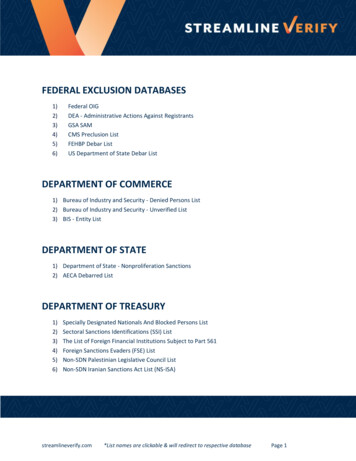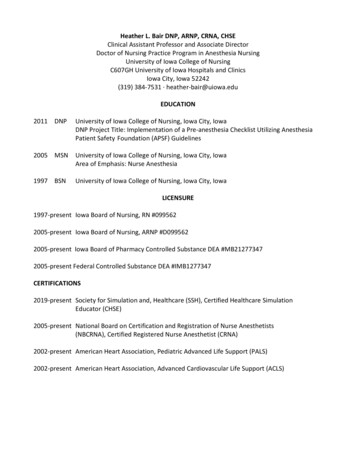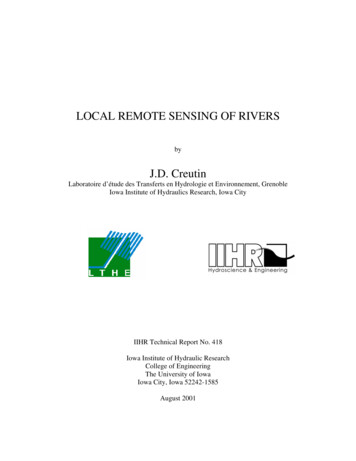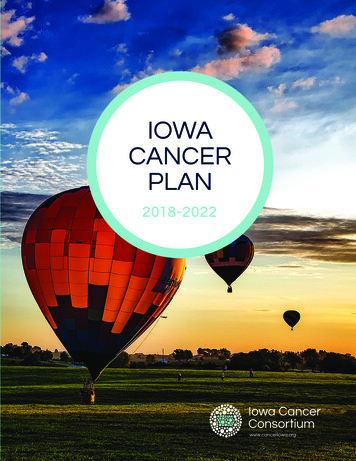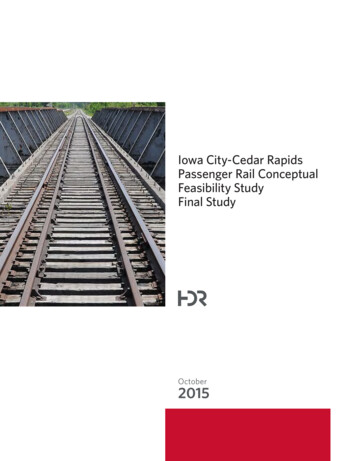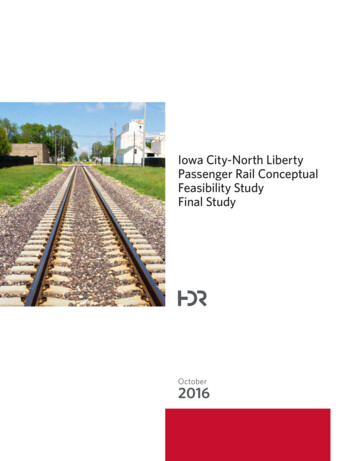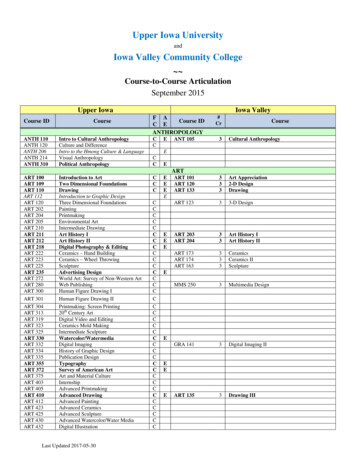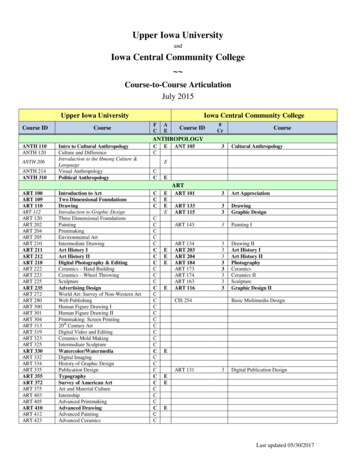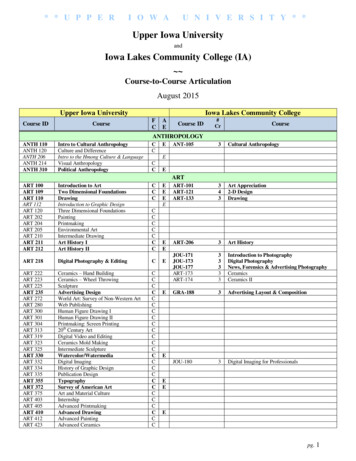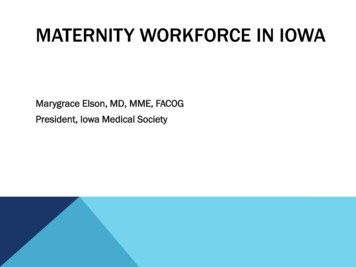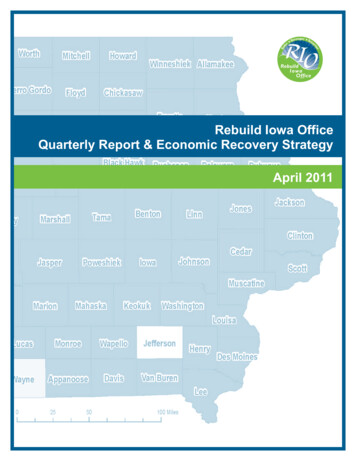
Transcription
Rebuild Iowa OfficeQuarterly Report & Economic Recovery StrategyApril 2011
R I O Q u a r t e r l y R e p o r t : Ap r i l 2 0 1 1Table of ContentsThe Rebuild Iowa Office State PartnershipsExecutive Summary45DISASTER OVERVIEW & BACKGROUNDDisaster SummaryIowa Disaster Events & Response TimelineThe RIO & the RIACRebuild Iowa Office & Advisory Commission Timeline891013ECONOMIC RECOVERY STRATEGY METHODSObtain & Expedite Disaster Recovery FundingIdentify & Quantify Disaster ImpactsPublic Outreach & AssistanceObtain Public & Expert InputEnact Policy & Legislative Changes1620223034ECONOMIC RECOVERY STRATEGY ROAD MAPGoal 1: Housing RecoveryGoal 2: Business & Workforce RecoveryGoal 3: Infrastructure InvestmentsGoal 4: Individual Services & GuidanceGoal 5: Local Economic RecoveryGoal 6: Smart PlanningGoal 7: Statewide Mitigation PlanningGoal 8: Floodplain & Watershed ManagementGoal 9: Floodplain MappingGoal 10: Quality of ps, Charts & GraphsGlossaryIowa Disaster Recovery Funding TimelineIowa Disaster Recovery Assistance Programs TimelineDisaster Recovery Funding SourcesRebuild Iowa Office Budget & ExpendituresRebuild Iowa Office StaffingRebuild Iowa Office Contracts1281291301321361441451463
The Rebuild Iowa OfficeState PartnershipsThe Rebuild Iowa Office works in partnership with the following stateagencies in Iowa’s recovery from the devastating storms, tornadoes andflooding of 2008:Board of Regents, State of IowaIowa College Student Aid CommissionIowa Department of Agriculture and Land StewardshipIowa Department of Cultural AffairsIowa Department of Economic DevelopmentIowa Department of EducationIowa Department of Human ServicesIowa Department of ManagementIowa Department of Natural ResourcesIowa Department of Public DefenseIowa Department of Public HealthIowa Department of Public SafetyIowa Department of RevenueIowa Department of TransportationIowa Department on AgingIowa Finance AuthorityIowa Homeland Security and Emergency Management Division, DPDIowa Insurance DivisionIowa Office of Energy IndependenceIowa Utilities BoardIowa Workforce DevelopmentState Fire Marshal Division, DPS4
R I O Q u a r t e r l y R e p o r t : Ap r i l 2 0 1 1Executive SummaryThis Quarter’s report is the final one for the Rebuild Iowa Office as the office approaches itssunset date at the end of June 2011. In this report, the background, methods toward economicrecovery, and progress toward recovery goals are identified and detailed information is provided.This report includes transition recommendations and strategies for the future of disaster recoverythat will require the participation of leaders and agencies outside of the RIO.The first section provides a disaster overview and background. Given that this is historicalinformation, it largely has not changed since the last report. A complete timeline of the majorevents of the Rebuild Iowa Office and Advisory Commission is included in this section.The following section documents the RIO’s methods used toward achieving economic recoveryfor the state. These methods include: Obtain and Expedite Disaster Recovery Funding; Identifyand Quantify Disaster Impacts; Public Outreach and Assistance; Obtain Public and Expert Input;and Enact Policy and Legislative Changes. In the last three months, total recovery fundingavailable to the state has largely remained the same, with no major new sources; however,expenditures of these funds have increased by more than 200 million. This section of the reportalso outlines new data collected from the most heavily impacted communities in the state. Thisdata paints a picture of a recovery that is well under way, but with major hurdles remaining. Whilemost displaced homeowners have returned to a repaired home or moved to another property,some properties that were destroyed still await buy-out and demolition. Most businesses havereopened, while some have determined that they will remain closed. Several impactedgovernment buildings are still in the process of being replaced.Each of the 10 goal sections provides an overview of the background and programs that havebeen created to reach that goal. Each section also includes several objectives and the progress,measures and strategy going forward to reach those objectives is outlined. These sections showthat work remains not only in overall recovery, but also toward the goal of creating a more resilientstate for future disasters. Hazard mitigation, planning, watershed management and otherimportant initiatives need to continue and are in jeopardy as other critical issues in the state takeprecedence.The appendix to this report includes several important reference materials including local programcontact information, funding and program timelines, a glossary of recovery terms, an overview ofall funding sources, updated charts on the progress of those funding sources, and information onthe RIO’s budget, expenditures, staffing and contracts.5
6
R I O Q u a r t e r l y R e p o r t : Ap r i l 2 0 1 1DISASTER OVERVIEW& BACKGROUNDIn 2008, Iowa experienced the most devastating series of natural disasters in the state’shistory. Between May 25, 2008, and Aug. 13, 2008, more than 85 of Iowa’s 99 counties wereimpacted by floods, tornadoes and severe weather. This section provides an outline of how theevents in 2008 unfolded, and explains the magnitude of the destruction that followed.In an effort to address the disasters, the Rebuild Iowa Office (RIO) and Rebuild Iowa AdvisoryCommission (RIAC) were established to coordinate the statewide short- and long-term recoveryeffort. After the RIO and RIAC’s formation, task forces were created to address issues likehousing, agriculture, infrastructure, economic and workforce development, hazard mitigation andfloodplain management. Since June 2008, there have been hundreds of meetings with local andnational experts, as well as impacted Iowans. The discussions have led the RIO to the long-termrecovery goals outlined in this report.
DISASTER OVERVIEW & BACKGROUNDDisaster SummaryThe State of Iowa suffered its most devastating disaster in 2008.Throughout the spring and summer, the state was hit by tornadoes, severethunderstorms, hail and floods. Between May 25 and Aug. 13, 2008, 85 ofIowa’s 99 counties were declared Federal Disaster Areas.Iowa’s 2008 disaster is one of the largest in the nation’s history in terms ofdamage to public infrastructure. In response to these incidents, Gov. ChetCulver established the Rebuild Iowa Office (RIO) through Executive Order7 on June 27, 2008, to coordinate the statewide recovery effort.Cedar RapidsIdentifying all of the damages and impacts, and placing an exact dollarvalue on them, is impossible. People seeking this precise total dollar figurewill be disappointed. Most damage data are estimates and are often notfinal until many years following a disaster. The data often changes daily,and in some cases is never collected in a uniform way. Much of the datacollected is based on one specific program and does not provide an overallpicture. However, it has been estimated that Iowa’s 2008 disaster causedapproximately 8 to 10 billion in damages statewide. Some estimateddamage figures include:Housing - Tens of thousands of Iowans had their housing situationimpacted and thousands of Iowans were displaced.Businesses - More than 5 billion in estimated damage,approximately 4,800 non-manufacturing small businesses and 800intermediate-sized businesses were impacted.ParkersburgAgriculture - 2.5 to 3 billion, estimated total damage to crops andgrain, equipment, agricultural infrastructure, and grain storage andhandling facilities.Infrastructure - Though it will not cover all of the need, FEMA’s PublicAssistance program is a good indicator of infrastructure damage.Iowa’s estimated Public Assistance funding now tops 1.7 billion.Oakville8
R I O Q u a r t e r l y R e p o r t : Ap r i l 2 0 1 1Iowa DisasterEvents & Response TimelineMay 200825Tornadoes and flooding hit Butler and Black Hawk counties, including the communities of Parkersburgand New Hartford.State Emergency Operations Center in Camp Dodge is activated.27Federal disaster declared for first Iowa counties (DR-1763-IA).June 20083FEMA/State Joint Field Office opens in Urbandale, IA.8Mason City (Cerro Gordo County) is impacted with heavy rain and flooding.Heavy rain tops the levee at New Hartford (Butler County) causing flooding.Iowa River surpasses flood stage of 22 feet.10Saylorville Dam (Polk County) is topped causing flooding.Coralville Reservoir (Johnson County) tops its emergency spillway.11Tornado hits the Little Sioux Boy Scout Ranch in Monona County.13Cedar River crests at 31.1 feet in Cedar Rapids (Linn County), nearly 20 feet above flood stage.14Two levees are breached in Des Moines (Polk County).15A levee breach occurs in Oakville (Louisa County).Coralville Lake crests at 716.97 feet above sea level (surpasses previous record of 716.71 feet).The Iowa River crests at 31.5 feet (surpasses previous record of 28.52 feet).21Cedar River drops below 12-foot flood stage for the first time since June 2 in Cedar Rapids (LinnCounty).24Water stops going over the Coralville Lake spillway.July 20087Iowa River falls below flood stage inJohnson County.Presidentially-Declared Disaster CountiesMay 25 - Aug. 13, 2008August 200813The federal disaster incident periodfor DR-1763-IA closes.In total, 85 of Iowa’s 99 countieswere declared.August 200929FEMA/State Joint Field Officecloses.30Iowa Recovery Center opens inUrbandale, IA.June 201130Rebuild Iowa Office closes.9
DISASTER OVERVIEW & BACKGROUNDT h e R I O & T h e R I ACREBUILD IOWA OFFICEMISSION, VISION &GOALSIOWA’S VISION FOR LONG-TERMRECOVERYIowans will thrive in a state thatvalues, safeguards and invests in itssustainable future, resilientcommunities, welcomingenvironment, vital economy,treasured lands and naturalresources, rich cultural history,global role and its entire people.RIO MISSIONThe Rebuild Iowa Office (RIO) willlead the State of Iowa’s efforts torebuild safer, stronger and smarterin the wake of the 2008 severestorms and catastrophic flooding.RIO VISIONA ready and responsiveorganization committed to rebuildinga resilient Iowa that’s safe,sustainable and economically strongfor its people, reaffirming its ties tothe land, rivers, environment andrich cultural history today andtomorrow.RIO GOALSProvide leadership incoordinating state recoveryefforts, in planning, programs,policy development, activities anddecisions.Provide redevelopment principlesand policies, link local/state/federal agencies, establishpriorities and secure fundingresources for recovery.Provide recovery information,services, guidance, status,updates and progress to Iowa.Improve disaster recoveryprocesses at the local, state andfederal level.10THE REBUILD IOWA OFFICE (RIO)As a result of the unprecedented levels of devastation and destructioncaused by storms and floods during the spring and summer of 2008, and inan effort to efficiently and effectively manage the resources that werecommitted to rebuild and recover, Governor Chet Culver established theRebuild Iowa Office through Executive Order 7 dated June 27, 2008. TheRebuild Iowa Office was officially established as a state agency in HouseFile 64, Iowa legislation which was signed into law on Feb. 2, 2009. Thislegislation directs the office to coordinate disaster recovery until June 30,2011. It also calls for quarterly reports to ―include an updated budgetaryand financial analysis including full-time equivalent positions, and progressin obtaining goals, benchmarks, and objectives.‖THE REBUILD IOWA ADVISORY COMMISSION (RIAC)The RIAC is a 15-member commission created by the Governor inExecutive Order 7. This group worked tirelessly throughout July and Augustof 2008 to visit communities impacted by the disaster, listen to experts,leaders and other stakeholders, and determine the top priorities for theimmediate recovery process. Each RIAC Commissioner chaired a taskforce, which was comprised of Iowans who donated their time to helpdevelop strategies for a statewide recovery.Task ForcesAgriculture & EnvironmentCultural Heritage & Records RetentionEconomic & Workforce DevelopmentEducationFloodplain Management & Hazard MitigationHousingInfrastructure & TransportationLong-Term Recovery PlanningPublic Health & Health Care
R I O Q u a r t e r l y R e p o r t : Ap r i l 2 0 1 1The RIAC 45-Day ReportThis report assembled by the RIAC included the following priorities and recommendations forshort-term recovery:1)Provide support and assistance to individuals2)Meet people’s immediate housing needs3)Provide incentives for the rebuilding and reopening of businesses and non-profits4)Begin floodplain mapping5)Create flexibility in funding options for local governments6)Expedite the flow of recovery funds7)Ensure public health is maintainedThese recommendations were a beginning template for the focus of the Rebuild Iowa Office andits partners. All were acted upon and many continue to be addressed.In September, October and November of 2008, members of the RIAC continued to meet anddelve more deeply into specific areas of disaster recovery. Hundreds of Iowans signed up forissue-specific Task Forces chaired by commission members to volunteer their time and effort tohelp establish priorities for Iowa’s disaster recovery. Each task force prepared a report to thelarger commission that assisted in the formulation of their long-term recommendations.The RIAC 120-Day ReportThis report assembled by the RIAC included the following priorities and recommendations for long-term recovery:1)Individual Services and Guidance - Iowa will provide advice and support to individuals andfamilies seeking assistance in making their way through the challenges of rebuilding theirlives in a disaster case management framework that has ongoing, lasting organizationalcapacity and processes in place to be sustained during non-disaster times.2)Housing - State and local governments will place a high priority on ensuring availability ofadequate, affordable housing and the availability of individuals and families to rent orpurchase those homes.3)The State should provide incentives for Iowa’s struggling small businesses, microenterprisesand non-profits for restoration and rebuilding of their businesses from this disaster and futuremajor disasters.4)Infrastructure Investments - The State should lead in planning, establishing expectationsstatewide, and securing funding for infrastructure repair, rebuilding and/or construction.5)The State should identify, create and sustain funding options and provide flexibility for local11
DISASTER OVERVIEW & BACKGROUNDREBUILD IOWAADVISORY COMMISSION(RIAC)and state governments to assist in rebuilding an even better Iowa.6)The State must invest in local emergency management agencies forthe central coordination function and work in all areas of emergencymanagement - preparedness, response, recovery and mitigation - toachieve the baseline capacity needed to keep Iowa safer from futuredisasters.7)The State should ensure policy and programs that sustain communityidentity, quality of life and cultural heritage.8)The State will lead in developing guidance and support for integrated,regional planning to address recovery and leverage multi-jurisdictionalstrengths for ongoing initiatives.9)The State will move state policy forward and lead the discussion withregional and local interests on floodplain and watershed management.Members:Lt. General Ron Dardis,Commission ChairBill BywaterJim DavisMichael EarleyBill GerhardKarris GoldenBrent HallingLinda LarkinNitza Lopez-CastilloCarroll ReasonerChuck RiekenAmy TruaxDale UehlingMark WandroBeverly Wharton10) The State will complete floodplain mapping for the entire state usingstate-of-the-art technology. The State will pursue and implement themapping process and related activities as expeditiously as isreasonable and practical.11) Rebuild Iowa Office Roles and Responsibilities - The State mustformalize the Rebuild Iowa Office and associated responsibilitiesrelated to the 2008 disaster recovery.12) All involved agencies, governments and interested parties shouldpromote and support communications and outreach initiatives toeducate and support Iowans as they recover and plan for futuredisasters.12
R I O Q u a r t e r l y R e p o r t : Ap r i l 2 0 1 1Rebuild Iowa Office &Ad v i s o r y C o m m i s s i o n T i m e l i n eJune 200827Ex. Order 7 creates the Rebuild Iowa Advisory Commission (RIAC) and Rebuild Iowa Office (RIO)July 200817RIAC meets for the first time in Des Moines31RIAC meets in Cedar RapidsAugust 20085RIAC meets in Wapello19RIAC meets in Cedar Falls22“Speak Up Iowa!” Public Input Final Report submitted to the RIAC25RIAC meets in Urbandale29RIAC meets in Urbandale31RIAC submits its 45-Day Report to Governor CulverOctober 20081RIAC meets in Des Moines31Unified Task Force Report submitted to RIACNovember 20086RIAC meets in West Des Moines13RIAC meets in Des Moines17RIAC submits its 120-Day Report to Governor Culver23RIAC meets in Des MoinesDecember 20089-10 Disaster Recovery Conference in CoralvilleFebruary 20092The RIO hosts its first ―Rebuild Iowa Day at the Capitol―; HF 64 is signed into law, establishing the RIOin code and creating the Rebuild Iowa Coordinating CouncilApril 200913The RIO releases its April Quarterly Report20The RIO submits its quarterly EDA progress reportMay 200911RIAC meets in Des Moines18Iowa Recovery Analysis Workshop19First meeting of the Rebuild Iowa Coordinating CouncilJuly 200910The RIO releases its July Quarterly Report21Rebuild Iowa Coordinating Council meeting27The RIO submits its quarterly EDA progress reportOctober 200913Rebuild Iowa Coordinating Council meeting; The RIO releases its October Quarterly Report27The RIO submits its quarterly EDA progress report13
DISASTER OVERVIEW & BACKGROUNDREBUILD IOWA COMMITTEES(2011 - 2012)The Rebuild Iowa Committees wereeliminated for the 84th General Assembly.The following committees may handlemuch of the disaster recovery legislationintroduced. Members include:SENATE ECONOMIC GROWTHCHAIR:Steve Sodders (D, 22)VICE CHAIR:Bill Dotzler (D, 11)RANKING MEMBER:Sandy Greiner (R, 45)Rob Bacon (R, 5)Rick Bertrand (R, 2)Tod Bowman (D, 13)Mark Chelgren (R, 47)Swati Dandekar (D, 18)Jeff Danielson (D, 10)Jack Hatch (D, 33)Tom Rielly (D, 38)Jim Seymour (R, 28)Pat Ward (R, 30)Mary Jo Wilhelm (D, 8)HOUSE ECONOMIC GROWTH ANDREBUILD IOWACHAIR:Pat Grassley (R, 17)VICE CHAIR:Mary Ann Hanusa (R, 99)RANKING MEMBER:Roger Thomas (D, 24)Rich Anderson (R, 97)Chip Baltimore (R, 48)Josh Byrnes (R, 14)Betty DeBoef (R, 76)Bob Hager (R, 16)Chris Hall (D, 02)Lisa Heddens (D, 46)Dave Jacoby (D, 30)Mark Lofgren (R, 80)Steve Lukan (R, 32)Helen Miller (D, 49)Dan Rasmussen (R, 23)Kirsten Running-Marquardt (D, 33)Jason Schultz (R, 55)Jeff Smith (R, 6)Chuck Soderberg (R, 3)Sharon Steckman (D, 13)John Wittneben (D, 07)14November 200924Optional teleconference for RIAC members to update legislative proposalsDecember 200917Rebuild Iowa Coordinating Council meetingJanuary 20108The RIO releases its January Quarterly Report14Rebuild Iowa Day at the Capitol25The RIO submits its quarterly EDA progress reportApril 20109The RIO releases its April Quarterly Report27Rebuild Iowa Coordinating Council meeting28The RIO submits its Quarterly EDA progress reportMay 201020Optional teleconference for RIAC membersJune 201024Iowa Disaster Recovery Tabletop ExerciseJuly 20109The RIO releases its July Quarterly Report31The RIO submits its quarterly EDA progress reportOctober 20108The RIO releases its October Quarterly Report31The RIO submits its final Economic Recovery Strategy to EDANovember 201016Rebuild Iowa Coordinating Council MeetingDecember 201017RIAC Special Meeting to review Transition Plan draftJanuary 20111Rebuild Iowa Office Transition Plan due to Governor and General Assembly10The RIO releases its January Quarterly ReportApril 20118The RIO releases its April Quarterly ReportJune 201130Rebuild Iowa Office scheduled to close
R I O Q u a r t e r l y R e p o r t : Ap r i l 2 0 1 1E C O N O M I C R E C O V E RYS T R AT E G Y M E T H O D SEven during the initial response phase of the disaster, Iowa’s leaders were already looking to thefuture. They realized the 2008 disasters were of the magnitude that state government’s usualresources would not be enough. With help from the Economic Development Administration (EDA),the Rebuild Iowa Office (RIO) was formed. The RIO’s main responsibility, through EDA,Community Development Block Grant funding and state appropriations, is to guide the recoveryprocess and develop an Economic Recovery Strategy for the state. This strategy will help to guideand track disaster recovery progress and suggest strategies, policy, projects and other means bywhich the state can rebuild safer, stronger and smarter.Several methods have been, and are being, implemented in order to develop the EconomicRecovery Strategy Road Map. These methods will help to determine and address damages,unmet needs, policy and strategy for Iowa’s long-term economic recovery.The Rebuild Iowa Office is scheduled to close in June 2011, per Iowa Code. The office wasrequired to submit a transition plan for this closing on Jan. 1, 2011. The plan was submitted to theGovernor’s office and Iowa General Assembly at that time. In addition to that report, the RIOmakes suggestions for transition of specific recovery strategy methods in the following section.15
ECONOMIC RECOVERY STRATEGY METHODSObtain & ExpediteDisaster Recovery FundingTHE RIO DISASTERFUNDING CHARTSThe RIO has created charts to showthe movement of funds from federaland state disaster aid programs tocommunities, businesses andindividuals in Iowa from the morethan 4.4 billion which hasbeen promised to the state fordisaster relief. The charts, which areupdated monthly, detail themovement of these funding sources.Obtaining and maximizing funding through federal, state and localresources is vital to recovery. So far, more than 4.4 billion has beenallocated for Iowa’s disaster recovery through state and federal programs(see Appendix). This funding is at various stages of commitment to specificprojects and individuals. However, more than 1.8 billion has been spent.KEY METHODS1)Monitor funding progress and unmet needs and communicatethat information across all levels of government and to the publicThe RIO monitors 2008 disaster-related funding information, includingissuing monthly expenditure reports which detail information on everyknown public funding source in the 2008 disaster recovery effort.For each specific source of funding,two graphs outline the status ofIowa’s progress. The firstgraph details how much has beenallocated to Iowa from the fundingsource, how much has beenapproved for state and/or localprograms, as well as the amountthat has actually been spent. Thesecond graph focuses on themonthly progress of thesefunds. These charts highlight morethan 20 different sources of disasteraid.Reported information includes the amount of funding that has beenallocated, approved and spent in Iowa. Allocated funds are those thathave been promised to Iowa through legislation or other means but arein various stages of program approval and may not necessarily beavailable for use. Approved funds are those that have been designatedto specific projects, areas or individuals and are available for use.In addition to statewide information, the RIO collects county-levelfunding information for programs when available. Of the nearly 40programs, some county-level data is available for 24 of them.All of the charts can be found on theRIO Web site www.rio.iowa.gov/funds.html.This information is distributed in a press release each month andposted online. Further information on total funding and each fundingsource can be found in the Appendix of this report.Transition Recommendation: Since recovery programs and projectswill continue past the life of the RIO, it will be important to provideregular funding updates. Agencies could continue to report to theLegislative Services Agency which could then make this informationavailable online.2)Advocate for funding needed to assist in rebuilding and recoveryto the greatest extent possibleThe RIO has worked with leaders at all levels to advocate for recoveryfunding. To date, Iowa has secured more than 4.4 billion, includingadditional CDBG funds that were awarded due to mitigation efforts.Transition Recommendation: Funding is still needed for a complete16
R I O Q u a r t e r l y R e p o r t : Ap r i l 2 0 1 1recovery, especially for infrastructure projects. State and congressional leaders shouldcontinue to seek funding.3)Ensure program design is effective in reducing red tape and expedite funding andensure that funding is prioritized to meet the most pressing needs and fairlydistributed both programmatically and geographicallyThe RIO has worked with local, state and federal agencies to review programs and policiesrelevant to disaster recovery and to ensure that program design and implementation isequitable, transparent and effective. One of the state’s most important lessons learned in thisdisaster is that many federal sources of funding are not designed for disaster relief and aretherefore difficult to administer effectively.Transition Recommendation: While programs for individuals and businesses are windingdown, infrastructure programs are still very active and communities need assistance inworking with federal agencies (particularly FEMA and the Army Corps of Engineers). Fundsare available, but approval of specific projects can be a burdensome process. State leadersshould continue to work with communities on these projects and advocate for their approval.4)Coordinate recovery efforts with federal, state and local entities from all sectorsAfter the disaster, the RIO coordinated Interagency Coordinating Team (IACT), a group ofmore than 40 state and federal agencies which met monthly for the first year of recovery. Thegroup later merged with the Rebuild Iowa Coordinating Council.In February 2009, HF 64 created the Rebuild Iowa Coordinating Council, made up of stateagencies, local leaders and legislators. This group was charged to facilitate ―communicationbetween state agencies and the RIO,‖ and meets quarterly.Transition Recommendation: The RIO Transition Plan released in January 2011, outlined aframework for ongoing and future recovery that included an office within HSEMD that wouldfocus on long-term recovery issues, policies and plans. This framework should be consideredto carry forward the best practices and lessons learned from the 2008 disaster recovery.5)Advocate for changes to the federal system of funding disaster recoveryIowa’s experience led the state to conclude major federal reforms are needed to improve howfuture disaster recoveries are handled. The RIO sought input from those involved in Iowa’srecovery to create an overarching set of recommended changes to the federal system.Reforming recovery in the United States requires a fundamental shift in the approach of howthe federal government plans for and handles major disasters. While disaster response has acoordinating agency and a structure with established programs, recovery does not. To ensurewell-coordinated recoveries that maximize opportunities while minimizing the long-termnegative impacts, the state recommends that the federal government create a nationaldisaster recovery framework with one coordinating body, one set of rules and expectations17
ECONOMIC RECOVERY STRATEGY METHODSTHE REBUILD IOWACOORDINATING COUNCILThe Rebuild Iowa CoordinatingCouncil, consisting of state agencyrepresentative, local leaders andlegislators with federal agencyparticipation, meets quarterly toshare their ideas and experiences inIowa’s disaster recovery efforts.The Council participated in eventsoutside of meetings, including the―Road Ahead Workshop‖ in July2009, which allowed members todiscuss key aspects of the disasterrecovery process, outline bestpractices and suggestimprovements, goals andbenchmarks in Iowa’s recovery.In June 2010, the group participatedin Iowa’s first ever DisasterRecovery Tabletop Exercise. Thisdiscussion-based exercise allowedthem to discuss their roles and thestate’s responsibilities in a futurelong-term disaster recovery. Thisexercise has led to the developmentof a Disaster Recovery Framework.The RICC also met in November2010, to discuss draft plans for aRIO Transition Plan and providetheir feedback and comments.and funding and programs designed with long-term recovery in mind,addressing the following issues and elements:Flexible and predictable disaster-track funding for a set threshold ofmajor disastersProvide states with up-front (not reimbursement-based) blockgrant recovery funding immediately following a major disaster.Use a formula that is consistent across all states and disastersbased on damages or other program funding.Allow states to set program priorities and parameters includingincome limits and other regulations including lead abatement andthe use of volunteer labor.Allow for a global local match requirement that calls state andlocal governments to contribute a certain percentage to overallrecovery, not individual programs and projects.A shared, real-time data system for all levels of governmentCreate a shared database for information and applications fromthose impacted that is a part of a coordinated system of casemanagement for impacted individuals.Allow impacted individuals to complete one application and signone privacy waiver that allows all government agencies to accesstheir recovery information.Allow all administering entities to update this database withinformation to improve the speed and accuracy of programs.Include comprehensive loss verification for each individual thatdocuments all loss so that multiple inspections and other checksare not nee
25 Tornadoes and flooding hit Butler and Black Hawk counties, including the communities of Parkersburg and New Hartford. State Emergency Operations Center in Camp Dodge is activated. 27 Federal disaster declared for first Iowa counties (DR-1763-IA). June 2008 3 FEMA/State Joint Field Office opens in Urbandale, IA.
